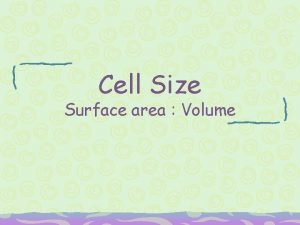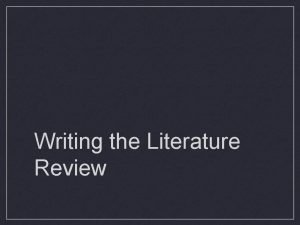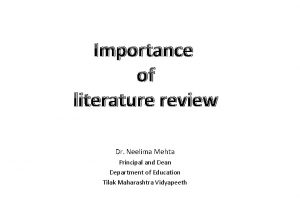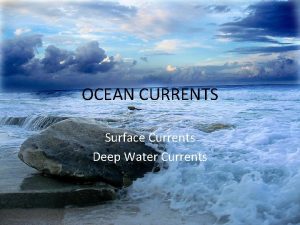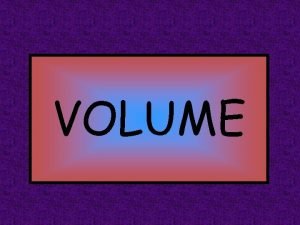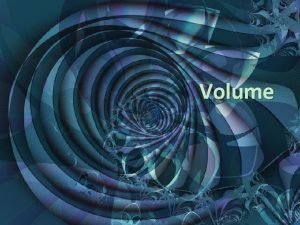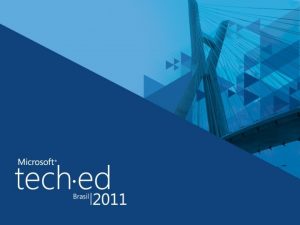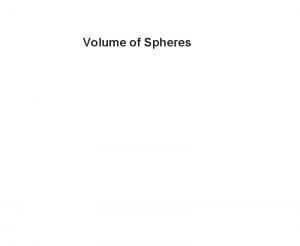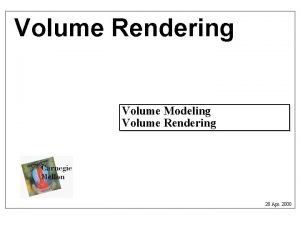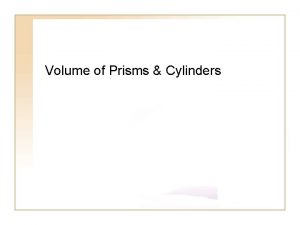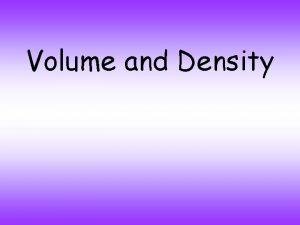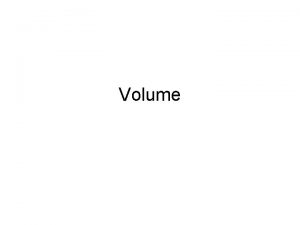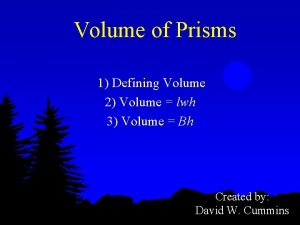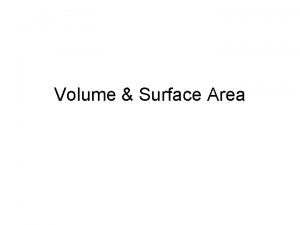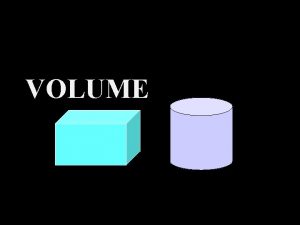A Review on the Importance of Volume Currents



















































- Slides: 51

A Review on the Importance of Volume Currents John C. Mosher Biological and Quantum Physics Group Los Alamos National Laboratory

Acknowledgements • Cite as: Mosher JC, “A Review on the Importance of Volume Currents, ” (invited presentation), 14 th International Conference on Biomagnetism, Boston, Massachusetts, August 2004, available as Los Alamos Technical Report LA-UR-04 -6117. • This work was supported by the National Institutes of Health under grant R 01 -EB 002010, and by Los Alamos National Laboratory, operated by the University of California for the United States Department of Energy, under Contract W-7405 -ENG-36. Dr. John C. Mosher, Los Alamos National Laboratory, Biomag 2004 Presentation, August 2004, LANL Technical Report # LA-UR-04 -6117

Abstract Given an elemental current dipole inside the brain, the forward problem is the calculation of the external scalp potential or the magnetic field; by superposition, any more complicated distribution of primary current can be found by integration or summation of the basic solution. Although the solutions have been derived over the last four decades under a variety of situation, some users remain uncertain about the effects of the volume currents in the models. The confusion may arise in part because most forward models have been reworked to make the volume currents implicit, rather than explicit. We review the general development of the forward solution, including our discovery of an early 1971 paper missed by the MEG community that elegantly yields the general solution. We discuss the principal computational issues in boundary element methods (BEMs) in accurately accounting for these volume currents, and how it impacts both MEG and EEG models. We also review the “myth” of the silent radial dipole, reviewing classic and recent work that shows that radial dipoles are generally measurable in MEG data under realistic conditions. Dr. John C. Mosher, Los Alamos National Laboratory, Biomag 2004 Presentation, August 2004, LANL Technical Report # LA-UR-04 -6117

Outline • Basic Assumptions, and the definition of Primary and Volume currents • Simple MEG solution and the possible confusion about volume currents • Historical review of the development of the general solutions for EEG and MEG • The “myth” of the “silent” radial dipole Dr. John C. Mosher, Los Alamos National Laboratory, Biomag 2004 Presentation, August 2004, LANL Technical Report # LA-UR-04 -6117

Excellent Mathematical Reference: • Jukka Sarvas, 1987, Physics in Medicine and Biology. Dr. John C. Mosher, Los Alamos National Laboratory, Biomag 2004 Presentation, August 2004, LANL Technical Report # LA-UR-04 -6117

Sarvas References: Dr. John C. Mosher, Los Alamos National Laboratory, Biomag 2004 Presentation, August 2004, LANL Technical Report # LA-UR-04 -6117

Basic Assumptions • Source region is non-magnetic • Currents are quasi-static – Electric field is gradient of a scalar – Curl of magnetic field is the current – Divergence of magnetic field is zero • Define static magnetic field as the curl of a “vector potential” A(r), yielding Dr. John C. Mosher, Los Alamos National Laboratory, Biomag 2004 Presentation, August 2004, LANL Technical Report # LA-UR-04 -6117

Magnetic Vector Potential • Integrate the total current density flowing in the head, divided by its distance to the observation. Brain. Storm Dr. John C. Mosher, Los Alamos National Laboratory, Biomag 2004 Presentation, August 2004, LANL Technical Report # LA-UR-04 -6117

Biot-Savart Law Vector potential CURL yields magnetic field But the Biot-Savart Law is expressed in total current, we need the solution in terms of the neural source generators. Dr. John C. Mosher, Los Alamos National Laboratory, Biomag 2004 Presentation, August 2004, LANL Technical Report # LA-UR-04 -6117

Primary vs. Secondary Currents • Picture primary current as a small • • battery inside the brain. Secondary or volume currents are the gradient currents to “complete the circuit. ” Boundaries shape the volume currents. Brain. Storm Dr. John C. Mosher, Los Alamos National Laboratory, Biomag 2004 Presentation, August 2004, LANL Technical Report # LA-UR-04 -6117

Primary Neural Sources • Primary currents are • • Ramon y Cajal 1888 from Hamalainen et al. 1993 Reviews of Modern Physics produced by current flow in apical dendrites in cortical pyramidal neurons. Millions of EPSPs summed over ~ten milliseconds. “Macrocellular” vs. “microcellular. ” Dr. John C. Mosher, Los Alamos National Laboratory, Biomag 2004 Presentation, August 2004, LANL Technical Report # LA-UR-04 -6117

Two Types of Current • Volume currents flow simply due to the presence of a macroscopic voltage gradient in conducting medium • Simply define Primary Current as “not volume” Dr. John C. Mosher, Los Alamos National Laboratory, Biomag 2004 Presentation, August 2004, LANL Technical Report # LA-UR-04 -6117

Unbounded Solutions Assume an unbounded homogeneous region: CURL: Homogeneous magnetic field DIVERGENCE: Homogeneous electric potential Dr. John C. Mosher, Los Alamos National Laboratory, Biomag 2004 Presentation, August 2004, LANL Technical Report # LA-UR-04 -6117

Numerical Example • Consider a dipole 7 cm up from an origin, and observation points arranged 12 cm from the origin. Dr. John C. Mosher, Los Alamos National Laboratory, Biomag 2004 Presentation, August 2004, LANL Technical Report # LA-UR-04 -6117

Primary Dipole Magnetic Fields Dr. John C. Mosher, Los Alamos National Laboratory, Biomag 2004 Presentation, August 2004, LANL Technical Report # LA-UR-04 -6117

Unbounded Regions • Volume currents do not contribute to the potential or magnetic field in infinite homogeneous regions • Volume currents only contribute when bounded regions are nearby Dr. John C. Mosher, Los Alamos National Laboratory, Biomag 2004 Presentation, August 2004, LANL Technical Report # LA-UR-04 -6117

Bounded Regions • Given primary current, what is the magnetic • field? MEG general solution includes the general solution of EEG surface potentials. Dr. John C. Mosher, Los Alamos National Laboratory, Biomag 2004 Presentation, August 2004, LANL Technical Report # LA-UR-04 -6117

Boundary Effects (cf. Sarvas) Dr. John C. Mosher, Los Alamos National Laboratory, Biomag 2004 Presentation, August 2004, LANL Technical Report # LA-UR-04 -6117

Fictitious Currents • Standard vector identities allow us to delete the true 3 -D volume currents and replace them with fictitious 2 -D currents only on the boundaries, normally oriented True physical currents All surface current elements discontinuous Dr. John C. Mosher, Los Alamos National Laboratory, Biomag 2004 Presentation, August 2004, LANL Technical Report # LA-UR-04 -6117

Radial Field Outside of a Sphere • In a sphere, then all fictitious currents are radial. • If a sensing coil is oriented radially outside of the a perfect sphere, then none of the fictitious currents are visible Radial fictitious currents are Unobservable by a radial sensor Dr. John C. Mosher, Los Alamos National Laboratory, Biomag 2004 Presentation, August 2004, LANL Technical Report # LA-UR-04 -6117

Radial Field Strength Dr. John C. Mosher, Los Alamos National Laboratory, Biomag 2004 Presentation, August 2004, LANL Technical Report # LA-UR-04 -6117

The Simple MEG Solution • Biot-Savart Law using All currents: • Spherical Case, Radial Direction: • Looks like the Biot-Savart Law, but only involves the primary current Dr. John C. Mosher, Los Alamos National Laboratory, Biomag 2004 Presentation, August 2004, LANL Technical Report # LA-UR-04 -6117

The Confusion • We can also write the spherical solution for the radial measurement as: • But this often leads novices to the conclusion that the volume currents are unimportant. For non-radial measurements in the orientation “o”, they attempt: Dr. John C. Mosher, Los Alamos National Laboratory, Biomag 2004 Presentation, August 2004, LANL Technical Report # LA-UR-04 -6117

Slightly Non-radial Measurements • Six degrees from radial in the y-direction Incorrect: Primary Currents Only Correct: Primary and Volume Currents Dr. John C. Mosher, Los Alamos National Laboratory, Biomag 2004 Presentation, August 2004, LANL Technical Report # LA-UR-04 -6117

Non-radial Field Outside of a Sphere • In non-radial directions, the fictitious currents are visible and must be included in the calculation Non-radial orientation Sensor and dipole in same orientation Primary current does NOT contribute! Dr. John C. Mosher, Los Alamos National Laboratory, Biomag 2004 Presentation, August 2004, LANL Technical Report # LA-UR-04 -6117

All Sensors in the X-direction • Sensors cannot see the primary current, only the volume currents Dr. John C. Mosher, Los Alamos National Laboratory, Biomag 2004 Presentation, August 2004, LANL Technical Report # LA-UR-04 -6117

General Solution Approach • Specify an elemental primary current source, calculate the infinite homogeneous potential, then solve the Fredholm Integral of the Second Kind for all boundary potentials (cf Sarvas): • Using this “EEG” solution, plug into “Geselowitz (1970) equation for MEG: Dr. John C. Mosher, Los Alamos National Laboratory, Biomag 2004 Presentation, August 2004, LANL Technical Report # LA-UR-04 -6117

Classical Solution Approach • First Edition 1962 Dr. John C. Mosher, Los Alamos National Laboratory, Biomag 2004 Presentation, August 2004, LANL Technical Report # LA-UR-04 -6117

Vector Spherical Harmonics Dr. John C. Mosher, Los Alamos National Laboratory, Biomag 2004 Presentation, August 2004, LANL Technical Report # LA-UR-04 -6117

Grynszpan and Geselowitz 1973 • Formalized the lead-field work of Baule and Mc. Fee (1965, 1970), using vector spherical harmonics Dr. John C. Mosher, Los Alamos National Laboratory, Biomag 2004 Presentation, August 2004, LANL Technical Report # LA-UR-04 -6117

The Simple Acknowledgement • 1975 Second Edition Dr. John C. Mosher, Los Alamos National Laboratory, Biomag 2004 Presentation, August 2004, LANL Technical Report # LA-UR-04 -6117

The Footnote • The clue, quite overlooked, that a simple solution existed. Dr. John C. Mosher, Los Alamos National Laboratory, Biomag 2004 Presentation, August 2004, LANL Technical Report # LA-UR-04 -6117

Bronzan, Am. Jrnl. Phys. 1971 Dr. John C. Mosher, Los Alamos National Laboratory, Biomag 2004 Presentation, August 2004, LANL Technical Report # LA-UR-04 -6117

Bronzan’s Solution (1971) • Magnetic scalar, given in terms of the total current. In the spherical boundaries case, only primary currents can contribute • Magnetic field is simply the gradient. Dr. John C. Mosher, Los Alamos National Laboratory, Biomag 2004 Presentation, August 2004, LANL Technical Report # LA-UR-04 -6117

Further MEG Development • Bronzan’s solution is still today not widely cited, and has only recently been cited in MEG literature (Jerbi et al. 2003 PMB). • As the MEG community began experimental measurements in the 1980 s, a solution was sought for the non-radial field outside of a sphere. 1984 Biomag in Vancouver Dr. John C. Mosher, Los Alamos National Laboratory, Biomag 2004 Presentation, August 2004, LANL Technical Report # LA-UR-04 -6117

Ambiguity of MEG Data • Consider again the physical case. A radially -oriented sensor cannot distinguish between the following cases: Volume currents are invisible Radial line currents are invisible Dr. John C. Mosher, Los Alamos National Laboratory, Biomag 2004 Presentation, August 2004, LANL Technical Report # LA-UR-04 -6117

General Solution for the Sphere • Sum the magnetic field for the two radial lines and the tangential cross elements. Take the limit as the tangential element is made small, yielding: • Unfortunately, while correct, the formula contained a singularity “ 0/0” condition at certain observation points. Dr. John C. Mosher, Los Alamos National Laboratory, Biomag 2004 Presentation, August 2004, LANL Technical Report # LA-UR-04 -6117

Correct Insight • Their insight was correct, however, that we did NOT need to calculate the volume currents explicitly: Dr. John C. Mosher, Los Alamos National Laboratory, Biomag 2004 Presentation, August 2004, LANL Technical Report # LA-UR-04 -6117

Sarvas Solution • 1987, Jukka Sarvas correctly exploited the observations of Ilmoniemi et al, yielding a concise closed-form linear algebra solution (independent of Bronzan’s development): Dr. John C. Mosher, Los Alamos National Laboratory, Biomag 2004 Presentation, August 2004, LANL Technical Report # LA-UR-04 -6117

Bronzan-Sarvas Model • 1971 Bronzan solved the general magnetic scalar solution. No specialization to primary currents and spherical geometry. • 1987 Sarvas independently addressed the specific spherical MEG case and provided the explicit gradient solution for the magnetic field. Dr. John C. Mosher, Los Alamos National Laboratory, Biomag 2004 Presentation, August 2004, LANL Technical Report # LA-UR-04 -6117

Full Magnetic Field Primary Current only Primary plus Volume Currents Dr. John C. Mosher, Los Alamos National Laboratory, Biomag 2004 Presentation, August 2004, LANL Technical Report # LA-UR-04 -6117

The Elegant Phantom Returning to the Ilmoniemi et al solution. Their insight led them to develop a phascinating phantom. These “triangular magnetic dipoles” are experimentally indistinguishable from a current dipole in a perfect sphere of conducting solution. Dr. John C. Mosher, Los Alamos National Laboratory, Biomag 2004 Presentation, August 2004, LANL Technical Report # LA-UR-04 -6117

Spatial Ambiguity • This phantom experimentally emphasizes – (1) the importance of the volume currents, which are now embodied in the radial lines, and – (2) the complete spatial ambiguity between two different current configurations. Dr. John C. Mosher, Los Alamos National Laboratory, Biomag 2004 Presentation, August 2004, LANL Technical Report # LA-UR-04 -6117

The Silent Radial Dipole • Return to the fictitious currents model No measurable signal, primary and fictitious are all radial. Indeed, there is NO external magnetic field in any direction. The field from the volume currents has exactly cancelled the field from the primary current. Dr. John C. Mosher, Los Alamos National Laboratory, Biomag 2004 Presentation, August 2004, LANL Technical Report # LA-UR-04 -6117

“Big” – “Big” Equals Zero • Radially-oriented current dipole generates itself a substantial homogeneous field. • Volume currents exactly negate this field everywhere. Dr. John C. Mosher, Los Alamos National Laboratory, Biomag 2004 Presentation, August 2004, LANL Technical Report # LA-UR-04 -6117

The “Myth” of the Radial Dipole • Two critical conditions: – The dipole must be perfectly radial. – The head must be perfectly spherical. • Re Radial: Hillebrand Barnes (Neuroimage 2002) recently found less the 5% of the cortical surface is within 15 degrees radial. Dr. John C. Mosher, Los Alamos National Laboratory, Biomag 2004 Presentation, August 2004, LANL Technical Report # LA-UR-04 -6117

Nearly Radial Dipole in a Sphere • Dipole six degrees in x-direction from radial, sensors radially oriented. Strength already 10% of that of the tangential dipole. At 15 degrees, strength is 25% of that of the tangential dipole. Dr. John C. Mosher, Los Alamos National Laboratory, Biomag 2004 Presentation, August 2004, LANL Technical Report # LA-UR-04 -6117

The “Myth” of the Spherical Head • A much older and often overlooked result of Grynszpan and Geselowitz (1973) examines a slight perturbation of the spherical head. • Let the minor axis of a prolate spheroid be 99. 5% that of the major axis. • The maximum external magnetic field for a radial source is now 10% of that for a tangential source. • Effectively, the radial dipole in a perfect sphere has been rotated to 6 degrees. Dr. John C. Mosher, Los Alamos National Laboratory, Biomag 2004 Presentation, August 2004, LANL Technical Report # LA-UR-04 -6117

Summary • Primary current source generates volume currents. – – If no primary current, then no volume current. But can have closed loop primary currents that generate no volume current. • The volume currents create differences in potentials on the scalp surface -> EEG. – Silent EEG sources include those with no volume currents. • In general, both the primary current and the volume currents contribute to the magnetic field. – Must first solve the EEG forward model before solving the MEG forward model. Dr. John C. Mosher, Los Alamos National Laboratory, Biomag 2004 Presentation, August 2004, LANL Technical Report # LA-UR-04 -6117

Summary continued • In the special case of spherical geometry and radial MEG measurements, then volume currents do not contribute to the measurement. – Only occurs in simulation, even a six degree offset from radial causes appreciable volume current signals in the sensor. • In the special case of spherical geometry and a radial source, then volume currents exactly cancel the primary signal, such that NO external magnetic field exists. – Only occurs in simulation, since head must be perfectly spherical. Dr. John C. Mosher, Los Alamos National Laboratory, Biomag 2004 Presentation, August 2004, LANL Technical Report # LA-UR-04 -6117

Summary continued • In the special case of spherical geometry, then the tangential magnetic field components may be calculated directly from the radial magnetic field components. – Therefore do not need explicitly to solve EEG problem first. – First solved in general by Bronzan 1971 using magnetic scalars, but result remains obscure. – Investigated by Ilmoniemi et. al in 1984, resulting in elegant “dry” phantom. – Solved explicitly by Sarvas 1987 for the MEG case. Dr. John C. Mosher, Los Alamos National Laboratory, Biomag 2004 Presentation, August 2004, LANL Technical Report # LA-UR-04 -6117
 What is deep current
What is deep current Importance of surface area to volume ratio
Importance of surface area to volume ratio Cell surface area definition
Cell surface area definition Lightmass importance volume
Lightmass importance volume Literature review
Literature review Definition of literature
Definition of literature Importance of literature
Importance of literature Pressure-volume loop
Pressure-volume loop End diastolic volume meaning
End diastolic volume meaning Volume of solute divided by volume of solution * 100
Volume of solute divided by volume of solution * 100 Lung capacity
Lung capacity Volume kerucut = .....x volume tabung *
Volume kerucut = .....x volume tabung * Large volume parenterals contain
Large volume parenterals contain Hình ảnh bộ gõ cơ thể búng tay
Hình ảnh bộ gõ cơ thể búng tay Bổ thể
Bổ thể Tỉ lệ cơ thể trẻ em
Tỉ lệ cơ thể trẻ em Gấu đi như thế nào
Gấu đi như thế nào Tư thế worm breton là gì
Tư thế worm breton là gì Hát lên người ơi alleluia
Hát lên người ơi alleluia Môn thể thao bắt đầu bằng chữ f
Môn thể thao bắt đầu bằng chữ f Thế nào là hệ số cao nhất
Thế nào là hệ số cao nhất Các châu lục và đại dương trên thế giới
Các châu lục và đại dương trên thế giới Cong thức tính động năng
Cong thức tính động năng Trời xanh đây là của chúng ta thể thơ
Trời xanh đây là của chúng ta thể thơ Cách giải mật thư tọa độ
Cách giải mật thư tọa độ Làm thế nào để 102-1=99
Làm thế nào để 102-1=99 độ dài liên kết
độ dài liên kết Các châu lục và đại dương trên thế giới
Các châu lục và đại dương trên thế giới Thơ thất ngôn tứ tuyệt đường luật
Thơ thất ngôn tứ tuyệt đường luật Quá trình desamine hóa có thể tạo ra
Quá trình desamine hóa có thể tạo ra Một số thể thơ truyền thống
Một số thể thơ truyền thống Cái miệng xinh xinh thế chỉ nói điều hay thôi
Cái miệng xinh xinh thế chỉ nói điều hay thôi Vẽ hình chiếu vuông góc của vật thể sau
Vẽ hình chiếu vuông góc của vật thể sau Biện pháp chống mỏi cơ
Biện pháp chống mỏi cơ đặc điểm cơ thể của người tối cổ
đặc điểm cơ thể của người tối cổ V cc cc
V cc cc Vẽ hình chiếu đứng bằng cạnh của vật thể
Vẽ hình chiếu đứng bằng cạnh của vật thể Phối cảnh
Phối cảnh Thẻ vin
Thẻ vin đại từ thay thế
đại từ thay thế điện thế nghỉ
điện thế nghỉ Tư thế ngồi viết
Tư thế ngồi viết Diễn thế sinh thái là
Diễn thế sinh thái là Dot
Dot Số nguyên là gì
Số nguyên là gì Tư thế ngồi viết
Tư thế ngồi viết Lời thề hippocrates
Lời thề hippocrates Thiếu nhi thế giới liên hoan
Thiếu nhi thế giới liên hoan ưu thế lai là gì
ưu thế lai là gì Khi nào hổ mẹ dạy hổ con săn mồi
Khi nào hổ mẹ dạy hổ con săn mồi Khi nào hổ con có thể sống độc lập
Khi nào hổ con có thể sống độc lập


